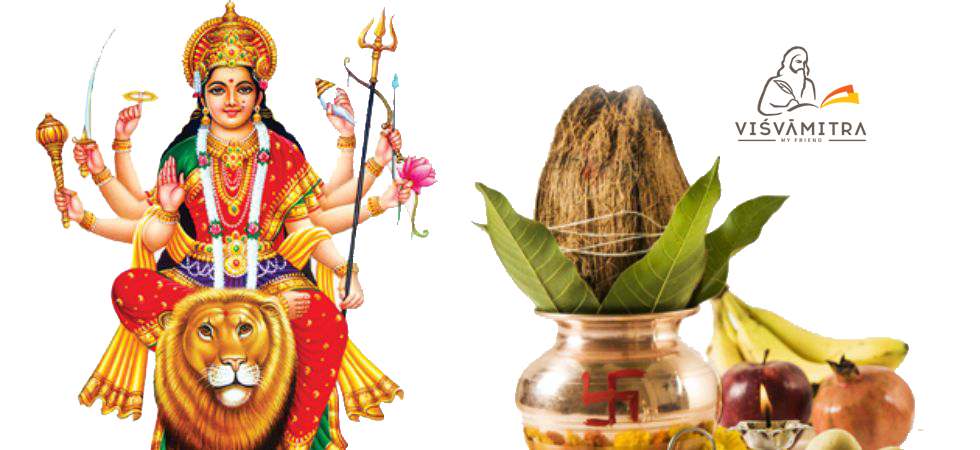Navaratri stands for nine nights. In these nine nights, nine different forms of Goddess Durga is worshipped.
Day 1: Shailaputri
First day is Known as Pratipada, this day is associated to Shaliputri (literally “Daughter of Mountain”), an incarnation of Parvati. It is in this form that the Goddess is worshiped as the consort of Shiva; she is depicted as riding the bull, Nandi, with a Trishula (a trident) in her right hand and lotus in her left. Shailaputri is considered to be the direct incarnation of Mahakali. The color of the day is red, which depicts action and vigor.
Day 2: Brahmacharini
On Dvitiya, Goddess Brahmacharini, another incarnation of Parvati, is worshiped. In this form, Parvati became Sati, her unmarried self. Brahmacharini is worshiped for emancipation or moksha and endowment of peace and prosperity. Depicted as walking bare feet and holding a japamala and kamandala in her hands, she symbolizes bliss and calm. Blue is the color code of this day. Blue colour depicts tranquility yet strong energy.
Day 3: Chandraghanta
Tritiya commemorates the worship of Chandraghanta – the name derived from the fact that after marrying Shiva, Parvati adorned her forehead with half-chandra (lit. moon). She is the embodiment of beauty and is also symbolic of bravery. Yellow is the colour of the third day, which is a vivacious colour and can pep up everyone’s mood.
Day 4: Kushmanda
Goddess Kushmanda is worshiped on Chaturthi. Believed to be the creative power of universe, Kushmanda associated to the endowment of vegetation on earth and hence, the color of the day is Green. She is depicted as having eight arms and sits on a Tiger.
Day 5: Skandmata
Skandamata, the goddess worshiped on Panchami, is the mother of Skanda (or Kartikeya). The color Grey is symbolic of the transforming strength of a mother when her child is confronted with danger. She is depicted riding a ferocious lion, having four arms and holding her baby.
Day 6: Katyayani
Born to a sage, Katyayana, she is an incarnation of Durga and is shown to exhibit courage which is symbolized by the color Orange. Known as the warrior goddess, she is considered one of the most violent forms of Goddess Parvati. In this avatar, Katyayani rides a lion and has four hands.
Day 7: Kalaratri
Considered the most ferocious form of Goddess Durga, Kalaratri is revered on Saptami. It is believed that Parvati removed her fair skin to kill the demons Sumbha and Nisumbha. The color of the day is White. On Saptami, the Goddess appears in a white colour attire with a lot of rage in her fiery eyes, her skin turns black.
Day 8: MahaGauri
MahaGauri symbolizes intelligence and peace. The color associated to this day is Pink which depicts optimism.
Day 9: Siddhidatri
On the last day of the festival also known as Navami, people pray to Siddhidatri. Sitting on a lotus, she is believed to possess and bestows all type of Siddhis. Here she has four hands. Also known as Saraswati Devi, the embodiment of knowledge.
Interestingly, we have four Navaratras in a year.
Magha Navaratri: In the month of Magha (January–February), winter season. The fifth day of this festival is often independently observed as Vasanta Panchami, the official start of spring in the Hindu tradition.
Vasanta Navaratri: the second most celebrated, named after vasanta which means spring. It is observed the lunar month of Chaitra (March–April). wherein goddess Saraswati is revered through arts, music, and knowledge.
Ashada Navaratri: In the month of Ashadha (June–July), start of the monsoon season.
Sharada Navaratri: the most celebrated of the four Navaratri, named after Sharada which means autumn. It is observed the lunar month of Ashvin (September–October).
Navratri festival date and muhurat 2019
Magh Gupt Navratri 2019 (Magh Gupt Navratri 2019)
(5 February 2019 to 14 February 2019)
Chaitra Navratri 2019
(6 April 2019 to 14 April 2019)
Aashadh Gupt Navtari 2019 (Aashadh Gupt Navtari 2019)
(3 July 2019 to 11 July 2019)
Ashwin (Shardiya) Mahanavratra
(29 September 2019 to 7 October 2019)

